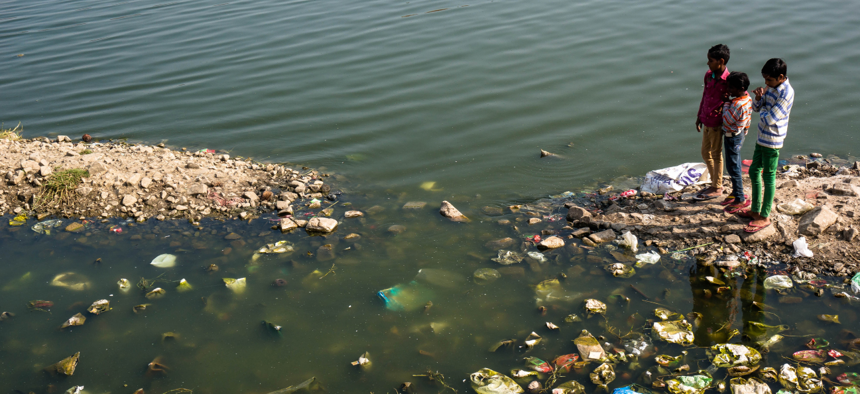
diy13 / istock
Addressing the Unfair Distribution of Costs and Benefits of Environmental Protection
How agencies can promote equity in the push for climate action.
The Biden administration is on track to confront climate change through a whole-of-government approach—putting climate at the center of executive decision making.
President Biden has committed to cutting greenhouse gas emissions by 50%-52% by 2030 relative to 2005 levels, a major boost from the previous target set by the Obama administration. The administration is also moving forward with the American Jobs Plan, a national effort aimed at creating jobs while building modern, sustainable infrastructure. And government agencies at every level, from federal to state and local, are stepping up their efforts to improve communities’ resilience to the impacts of climate change.
These efforts provide crucial opportunities to address a lingering oversight: the inequitable, unfair and unaffordable distribution of costs and benefits associated with environmental protection. The most severe harm from climate change falls disproportionately on underserved communities—those least able to properly prepare for, and recover from, environmental impacts from our warming planet, according to the EPA’s new Social Vulnerability Report.
For example, with 2°C of global warming, Black and African American individuals are 40% more likely to currently live in areas with the highest projected increases in extreme temperature related deaths. This percentage jumps to 59% under a scenario of 4°C of global warming. Additionally, Hispanics and Latinos—populations that have high participation in weather-exposed industries such as construction and agriculture—are 43% more likely to currently live in areas with the highest projected reductions in labor hours due to extreme temperatures.
These projections demonstrate the urgent need to prioritize and involve disadvantaged and marginalized populations in the clean energy transition, and to ensure that greenhouse gas mitigation or climate adaptation policies don’t leave them behind.
There are many ways to address these needs, but useful starting points are to invest in climate risk and social vulnerability assessments, involve disadvantaged groups in the assessment process, and ensure active participation of these people in decision-making. Equipped with an understanding of differential vulnerabilities, informed by the experience and perspectives of those most affected, decision makers can develop solutions that are both effective and equitable.
How to Prioritize Equity in Climate Planning
Historically marginalized groups, including indigenous peoples, low-income communities, racial and ethnic minorities, and LGBT+ populations, many of whom have been disproportionately impacted by the COVID-19 pandemic, are most vulnerable to the harmful effects of climate change. For example, studies have found racial disparities in potential exposure to extreme heat events in cities, and other types of extreme events such as severe storms, floods, and droughts frequently highlight disparities in exposure and vulnerability across populations. Even some measures to reduce greenhouse gas emissions, particularly those that lead to higher energy costs, can disproportionately affect low-income communities.
When trying to prioritize equity in climate planning, many decision-makers fail to realize the full scope of problems facing marginalized communities or the deeply interconnected nature of social identities such as race, class, disability, gender identity, sexual orientation, and age. Climate vulnerability and risk assessments that consider social vulnerability are essential tools for identifying these issues and connections, and for establishing effective pathways to address risks. For example, in the climate vulnerability assessment that ICF conducted for the City of Philadelphia in 2015, we used climate and demographic data to map locations of vulnerable populations, focusing on older adults and people living below the poverty level. The locations identified across the city were compared with a map of the city’s heat islands and locations of cooling shelters, identifying areas where vulnerable populations may not have access to shelters during extreme heat events.
Stakeholder involvement is another key aspect of equitable climate planning. Vulnerable populations must have a role in assessment, planning, and decision making processes: nobody understands their situations, needs, and capabilities better than they do. We have seen diverse voices and perspectives come to life through our climate risk assessments around the world, where the province involved Indigenous communities in the assessment process through interviews and workshops. The impetus for engagement can come from disadvantaged groups themselves: for example, NAACP’s Environmental and Climate Justice Program offers free workshops on flood risk planning to help vulnerable populations in coastal communities understand their risks and engage with their leaders to develop action plans to address them.
A Path Forward
Ultimately, equity considerations must be integrated in greenhouse gas mitigation efforts, climate vulnerability and risk assessments, and planning and policy making. Prioritizing equity means partnering with marginalized populations and organizations that represent them, identifying potential inequities in climate-related risks and responses, and jointly developing approaches to address them. It also means building equity considerations into existing decision-making criteria and planning processes rather than tacking them on as an afterthought.
As consultants, we see many opportunities to work with our federal, regional, state, and local clients in the United States and internationally to advance progress in climate equity and justice. Those opportunities are rooted in understanding the people who will be most affected by climate change and the efforts to address it.
Susan Asam is vice president of climate and resilience and Brad Hurley is senior communications consultant at consulting firm ICF. Both are senior fellows at ICF’s Climate Center.






